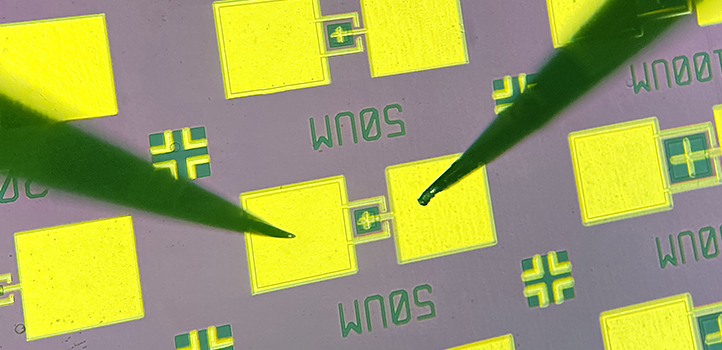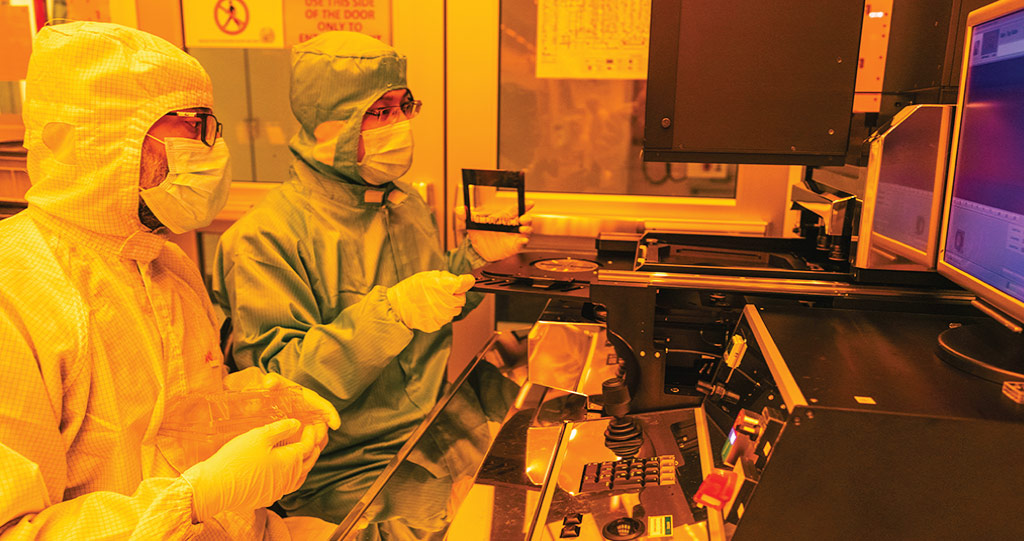Electrical Engineering
Making the shift from blue to red for better LEDs
Pure red-light micrometer-scale emitting devices made from a nitride semiconductor reaches excellent efficiency.

KAUST scientists have developed a red-light micrometer-scale LED with excellent efficiency. © 2021 KAUST; Anastasia Serin /en/article/1127/making-the-shift-from-blue-to-red-for-better-leds
KAUST scientists have developed a red-light micrometer-scale LED with excellent efficiency. © 2021 KAUST; Anastasia Serin /en/article/1127/making-the-shift-from-blue-to-red-for-better-leds
A new micro-light-emitting diode (micro-LED) developed at KAUST can efficiently emit pure red light and may help in the quest to develop full-color displays based on just a single semiconductor.
Micro-LEDs are a promising technology for the next generation of displays. They have the advantage of being energy efficient and very small. But each LED can only emit light over a narrow range of colors. A clever solution is to create devices that combine many different LEDs, each emitting a different color. Full-color micro-displays can be created by combining red, green and blue (RGB) micro-LEDs. Now, a KAUST team of Zhe Zhuang, Daisuke Iida and Kazuhiro Ohkawa have worked to develop a more efficient red LED.

Prof. Kazuhiro Ohkawa (left) and Zhe Zhuang (right) created the full-color micro-displays by combining red, green and blue micro-LEDs.
© 2021 KAUST; Anastasia Serin
The emission color of an LED is determined by the material properties of the semiconductor. For example, nitride semiconductors can be used to make blue and green micro-LEDs, whereas phosphide semiconductors are used for red light. But combining different semiconductors in this way makes construction of RGB micro-LEDs more difficult and expensive. Besides, the efficiency of phosphide micro-LEDs reduces significantly with shrinking chip size.
Red-light emitting indium gallium nitride can be created by increasing the materials’ indium content. But this tends to lower the efficiency of the resulting LED because there is a mismatch between the separation of atoms in the GaN and InGaN, which causes atomic-level imperfections. Moreover, damage to the sidewalls of an InGaN micro-LED induced during the fabrication process makes the new device less efficient. “But we have a chemical treatment to remove the damage and retain the high crystal quality of the InGaN and GaN sidewall interface,” explains Zhuang.

The 47-micrometer-long devices developed by the team have a very high external quantum efficiency.
© 2021 KAUST; Anastasia Serin
Zhang’s team created and characterized a series of square devices with a side-length of 98 or 47 micrometers. Their 47-micrometer-long devices emitting light at a peak wavelength of 626 nanometers were shown to have an external quantum efficiency — the number of photons emitted from the LED per electron injected into the device — of up to around 0.87 percent. Also, the color purity of the red micro-LED is optimum because it is very close to the primary red color defined by the industrial standard known as Rec. 2020.
“The next step is to increase the efficiency of the red micro-LED with even smaller chip sizes, maybe below 20 micrometers,” says Zhuang. “Then we hope to integrate RGB nitride-based LEDs for full-color displays.”

The micro-LED was developed in KAUST’s state-of-the-art Nanofabrication Core Lab.
© 2021 KAUST; Anastasia Serin
References
- Zhuang, Z., Iida, D. & Ohkawa, K. Investigation of InGaN-based red/green micro-light-emitting diodes. Optics Letters 46, 1912- 1915 (2021).| article
You might also like

Bioengineering
Smart patch detects allergies before symptoms strike

Computer Science
Green quantum computing takes to the skies

Electrical Engineering
Micro-LEDs boost random number generation

Bioengineering
Sensing stress to keep plants safe

Computer Science
Sweat-sniffing sensor could make workouts smarter

Electrical Engineering
New tech detects dehydration by touching a screen

Electrical Engineering
A new interface for efficient electronics

Electrical Engineering




